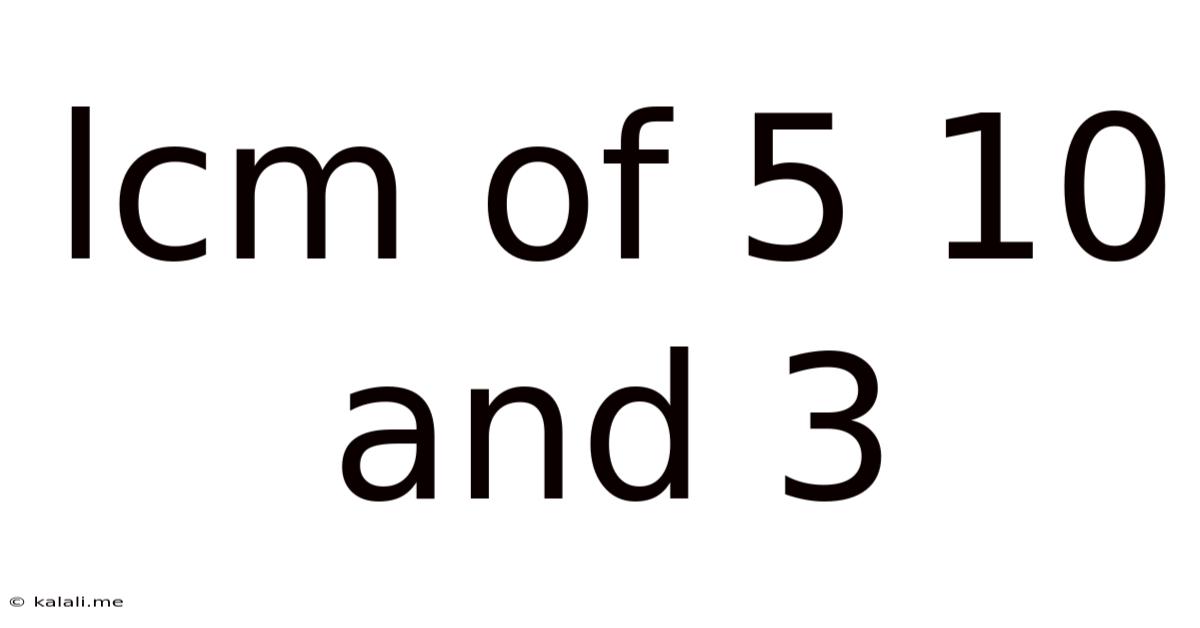Lcm Of 5 10 And 3
Kalali
Jun 11, 2025 · 3 min read

Table of Contents
Finding the Least Common Multiple (LCM) of 5, 10, and 3
This article will guide you through the process of calculating the Least Common Multiple (LCM) of 5, 10, and 3. The LCM is the smallest positive integer that is a multiple of all the given numbers. Understanding how to find the LCM is crucial in various mathematical applications, from simplifying fractions to solving problems involving cyclical events. This article will cover the most common methods, ensuring you understand the concept thoroughly.
Understanding Least Common Multiples
Before we dive into the calculation, let's clarify what a least common multiple is. A multiple of a number is the result of multiplying that number by any integer. For example, multiples of 5 are 5, 10, 15, 20, and so on. The LCM, as the name suggests, is the smallest number that is a multiple of all the numbers in a given set. In our case, we need to find the smallest number that's a multiple of 5, 10, and 3.
Method 1: Listing Multiples
The simplest method, especially for smaller numbers, is to list the multiples of each number until you find a common multiple.
- Multiples of 5: 5, 10, 15, 20, 25, 30, 35...
- Multiples of 10: 10, 20, 30, 40, 50...
- Multiples of 3: 3, 6, 9, 12, 15, 18, 21, 24, 27, 30, 33...
By comparing the lists, we can see that the smallest number appearing in all three lists is 30. Therefore, the LCM of 5, 10, and 3 is 30.
Method 2: Prime Factorization
This method is more efficient for larger numbers. It involves breaking down each number into its prime factors. A prime factor is a number that is only divisible by 1 and itself (e.g., 2, 3, 5, 7, etc.).
- Prime factorization of 5: 5 (5 is a prime number)
- Prime factorization of 10: 2 x 5
- Prime factorization of 3: 3 (3 is a prime number)
Next, we identify the highest power of each prime factor present in the factorizations:
- The highest power of 2 is 2<sup>1</sup> = 2
- The highest power of 3 is 3<sup>1</sup> = 3
- The highest power of 5 is 5<sup>1</sup> = 5
Finally, we multiply these highest powers together: 2 x 3 x 5 = 30. This confirms our result from Method 1.
Method 3: Using the Greatest Common Divisor (GCD)
The LCM and GCD (Greatest Common Divisor) are related. There's a formula that connects them:
LCM(a, b) x GCD(a, b) = a x b
While this method is less intuitive for three numbers, it can be extended. You would first find the LCM of two numbers (e.g., LCM(5,10)), then find the LCM of that result and the third number (LCM(LCM(5,10), 3)). However, for this specific example, the previous methods are simpler.
Conclusion
The Least Common Multiple of 5, 10, and 3 is 30. This article demonstrated three different methods to arrive at this answer. Choosing the most appropriate method depends on the numbers involved and your preference. Understanding LCM is fundamental to many mathematical concepts, and mastering these methods will equip you to tackle more complex problems with confidence.
Latest Posts
Latest Posts
-
How Many Positions Are There In Sex
Jul 02, 2025
-
How Many Minutes Are In 10 Miles
Jul 02, 2025
-
How Many Milliseconds Are In A Day
Jul 02, 2025
-
If Your 16 What Year Were You Born
Jul 02, 2025
-
Ten Thousand 2 Hundrad And 14 How To Writew Numercally
Jul 02, 2025
Related Post
Thank you for visiting our website which covers about Lcm Of 5 10 And 3 . We hope the information provided has been useful to you. Feel free to contact us if you have any questions or need further assistance. See you next time and don't miss to bookmark.